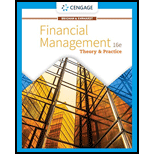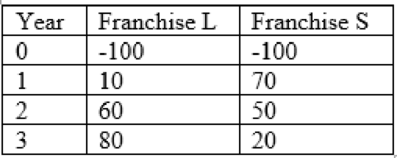
a)
Case summary:
The cash flows of Franchise L's would start off slowly however will rise rather quickly as people become much health-conscious, while the cash flows of Franchise S would start off high however will trail off as other chicken competitors comes inside the marketplace and as people become more health-conscious and avoid fried foods. Franchise L serves breakfast and lunch, whereas Franchise S serves only dinner, so it is possible for person X to invest in both franchises.
Here are the net cash flows (in thousand $)

To determine: The definition of
b)
To determine: The relationship between IRR and YTM and IRR if equal
c)
To determine: The logic behind the IRR method and the franchises should be accepted if they are independent and mutually exclusive.
d)
To determine: Whether IRR changes with respect to change in cost of capital.
Trending nowThis is a popular solution!

Chapter 10 Solutions
Financial Management: Theory & Practice
- Better plc is comparing two mutually exclusive projects, whose details are given below.The company’s cost of capital is 12 per cent.Project A Project B£m £mYear 0 (150) (152)Year 1 40 80Year 2 50 80Year 3 60 50Year 4 60 40Year 5 80 30(a). Using the net present value method, which project should be accepted?(b). Using the internal rate of return method, which project should be accepted?(c). If the cost of capital increases to 20 per cent in year 5, would your advice change? Hello.i have the solution you send me but i am trying to understand where did you get the calculations for in the worknotes tabel. I still cant calculate the IRR.i really dont understand how to do it. Can you help me please by using the numbers in the tabel so i can understand what is that you are adding or taking away please? I know how to calculate the NPV but not the IRR. I have went over and over this IRR but i still dont understand how you calculate it using the pv and the npv.i dont wanna use excel.arrow_forwardBetter plc is comparing two mutually exclusive projects, whose details are given below.The company’s cost of capital is 12 per cent.Project A Project B£m £mYear 0 (150) (152)Year 1 40 80Year 2 50 80Year 3 60 50Year 4 60 40Year 5 80 30(a). Using the net present value method, which project should be accepted?(b). Using the internal rate of return method, which project should be accepted?(c). If the cost of capital increases to 20 per cent in year 5, would your advice change? Hello.i have the solution you send me but i am trying to understand where did you get the calculations for in the worknotes tabel. I did my own calculation but i dont get the same answer. For example for year 2 for project A you have 39.8597 How did you get to that without using the formula in excel. I need to write down the actual numbers. I got 22.3214 some im not sure how you got to that number. Can you help me please? Thank youarrow_forwardSuppose Mullens Corporation is considering three average-risk projects with the following costs and rates of return: Project Cost Expected Rate of Return 1 $2,500 23.00% 2 $3,000 30.00% 3 $2,750 24.00% Mullens estimates that it can issue debt at a rate of rd=20.00%rd=20.00% and a tax rate of T=25.00%T=25.00%. It can issue preferred stock that pays a constant dividend of Dp=$20.00Dp=$20.00 per year and at Pp=$200.00Pp=$200.00 per share. Also, its common stock currently sells for P0=$16.00P0=$16.00 per share. The expected dividend payment of the common stock is D1=$4.00D1=$4.00 and the dividend is expected to grow at a constant annual rate of g=5.00%g=5.00% per year. Mullens’ target capital structure consists of ws=75.00%ws=75.00% common stock, wd=15.00%wd=15.00% debt, and wp=10.00%wp=10.00% preferred stock. 1.According to the video, the after-tax cost of debt can be stated as ________________ . Plugging in the values for rdrd and (T)T yields an after-tax cost of…arrow_forward
- I need help understanding a simple equation for this work problem The Maximus Corporation is considering a new investment, which would be financed from debt. Maximus could sell new $1,000 par value bonds at a new price of $920. The bonds would mature in 13 years, and the coupon interest rate is 10%. Compute the after-tax cost of capital to Maximus for bonds, assuming a 34% tax rate. Show workarrow_forwardYou are planning to invest in three mutually exclusive investment projects, A, B and C, which have the following after-tax cash flows: Cash Flow, per year ($) Investment 0 1 2 3 4 Thereafter A (12,000) 5,000 5,000 5,000 5,000 50 B (12,000) 0 0 0 20,000 50 C (12,000) 5,000 5,000 11,000 11,000 50 Assume that your required rate of return is 6.5 percent: Apply the present-value technique to assess the acceptability of each investment.arrow_forwardArmaan Incorporation, has two investment proposals, which have the following characteristics:PROJECT A PROJECT BPERIODCOSTPROFIT AFTER TAXNET CASH FLOWCOSTPROFIT AFTER TAXNET CASH FLOW 0$9,000--$12,000-- 1 $1,000$5,000 $1,000$5,000 2 $1,000$4,000 $1,000$5,000 3 $1,000$3,000 $4,000$8,000 For each project, compute its payback period, its net present value, and its profitability index using a discount rate of 15 percent.arrow_forward
- Consider a two-date binomial model. A company has both debt and equity in its capital structure. The value of the company is 100 at Date 0. At Date 1, it is equally like that the value of the company increases by 20% or decreases by 10%. The total promised amount to the debtholders is 100 at Date 1. The riskfree interest rate is 10%. a. What is the value of the debt at Date 0? What is the value of the equity at Date 0? b. Suppose the government announces that it guarantees the company’s payment to the debtholders. How much is the government guarantee worth?arrow_forwardMontclair Company is considering a project that will require a $500,000 loan. It presently has total liabilities of $220,000 and total assets of $620,000. 1. Compute Montclair’s (a) current debt-to-equity ratio and (b) the debt-to-equity ratio assuming it borrows $500,000 to fund the project. 2. If Montclair borrows the funds, does its financing structure become more or less risky?arrow_forwardSuppose that you need to raise new financing for a large investment project. To keep your capital structure more-or-less close to the target, you decide to raise both debt and equity. Assume that the cost of floating a new bond issue will cost about 2% of the proceeds and new common stock will cost about 10% of the proceeds. you expect to pay $3.00 next year in dividends and grow them at roughly 2% for the foreseeable future. The firm’s tax rate is 21% you want to issue 20 year bonds with a $1,000 par value and a 9% coupon rate. you expect your stock to sell at$23 per share and your bonds to sell at par. What will the cost of equity and cost of debt (after-tax) be as a result of these new issues? What is the cost of capital if the target debt-equity ratio is 1.25?arrow_forward
- To assist with evaluating potential capital projects, Carrium Insights Inc. is seeking to determine its actual Weighted Average Cost of Capital (WACC). Utilising information from the financial statements, together with current information, the Finance Manager has compiled the following information as it pertains to the company’s capital structure: Debt: Bonds outstanding has a face value of $568,000,currently selling at 95% of par. These bonds have 20 years left to maturityandacoupon rate of 7.55%.(Hint: you can use the lowest multiple of $1,000 for the YTM calculation only) Common stock: 21,000 shares of common stock outstanding with a market price of $63.00.The company just paida dividend of $6.00; for ease of computation, dividends are expected to grow by 5% annually. Preferred stock:The company intends to offer 15,000 shares of preferred stock to the public at a price of $25.00 per share. The intention is to pay an annual dividend of $3.00. Additional Information: ✓The Company’s…arrow_forwardIn an effort to increase its customer base, a company set the project MARR at exactly the WACC. If equity capital costs 8% per year and debt capital costs 12.5% for the project, what is the equity-debt percentage mix of capital required to make the WACC = 10%?arrow_forwardQuestion What is primary and secondary market? An IPO is undertaken on primary or secondary market? What is the essential job of an investment banker? Why a stock exchange is called an auction market? What are the five basis principles of finance? Your company is considering choosing one of the two projects: Project Gold and Project Diamond. Each project will last 5 years and have no salvage value at the end. The company’s required rate of return for all investment projects is 9%. The cash flows of the two projects are provided below. Gold Diamond Cost $485 000 $520 000 Future Cash Flows Year 1 Year 2 Year 3 Year 4 Year 5 105 850 153 250 225 650 245 000 250 350 117 050 162 400 275 500 255 000 260 000 Required: Identify which project should your company accept based on Discounted Payback Period method if the payback criterion is maximum of 2.5 years.arrow_forward

